I still remember the first time I tasted authentic Hawaiian teriyaki chicken on the North Shore of Oahu. The sticky-sweet glaze. The charred edges. That unmistakable blend of soy, sugar, and ginger that somehow tastes nothing like mainland teriyaki. It’s been 15 years, and I’m still chasing that perfect balance of flavors in my own kitchen.
Hawaiian teriyaki chicken—locally known as “chicken hekka” or simply “teri chicken”—stands apart from its Japanese cousin in crucial ways. Its uniquely caramelized exterior owes everything to Hawaii’s multicultural history, where Japanese immigrants adapted their cooking techniques to local ingredients and influences from Chinese, Filipino, Korean, and native Hawaiian traditions. What resulted was someting entirely new: a dish with deeper sweetness, more pronounced ginger notes, and that signature mahogany glaze that practically glistens under the island sun.
Ingredients & Substitutions
For the Teriyaki Sauce:
- 1 cup shoyu (Hawaiian-style soy sauce) or regular soy sauce
- 1 cup brown sugar, packed (traditionally Hawaiian raw sugar)
- 1/4 cup fresh pineapple juice (canned will work in a pinch)
- 2 tablespoons mirin (sweet rice wine)
- 3 cloves garlic, finely minced
- 2 tablespoons fresh ginger, grated (about a 2-inch piece)
- 1 tablespoon sesame oil
- 1/2 small onion, very finely grated (with juices)
- 1 green onion, finely chopped (plus more for garnish)
For the Chicken:
- 3 pounds chicken thighs, boneless and skinless
- 2 tablespoons neutral oil (like canola)
- 1 tablespoon toasted sesame seeds (for garnish)
- Steamed white rice (for serving)
Finding genuine Hawaiian shoyu on the mainland can be tricky. If unavailable, mix regular soy sauce with a teaspoon of molasses to approximate the deeper flavor profile. The pineapple juice isn’t just for “Hawaiian flair”—it contains bromelain, an enzyme that helps tenderize the meat while adding subtle fruity notes that balance the saltiness. Trust me, its worth the extra effort to squeeze fresh.
Many home cooks skip the mirin, but don’t! This fermented rice wine provides that elusive umami undertone that distinguishes great teriyaki from merely good versions. If you’re alcohol-adverse, substitute with 2 tablespoons rice vinegar mixed with 1 teaspoon of honey.
Step-by-Step Instructions
Preparing the Signature Sauce:
- Combine shoyu, brown sugar, pineapple juice, mirin, minced garlic, grated ginger, sesame oil, grated onion, and chopped green onion in a medium saucepan. The finely grated onion is a secret weapon here—it adds body and natural sweetness to the sauce that powdered onion just cant replicate.
- Bring mixture to a gentle simmer over medium heat, stirring occasionally until sugar completely dissolves. Continue to simmer for 10-15 minutes until the sauce has reduced by about one-third and has thickened enough to coat the back of a spoon. Many recipes rush this step, but patience yields that proper sticky-lacquer consistency that defines Hawaiian teri chicken.
- Remove from heat and allow to cool slightly before using. The sauce will continue to thicken as it cools, so don’t reduce it too far. If it becomes too thick, simply thin with a little water or pineapple juice. You’ll know its perfect when it has the consistency of warm maple syrup.
Preparing the Chicken:
- Trim excess fat from chicken thighs and pat dry with paper towels. This step is non-negotiable—wet chicken steams rather than caramelizes. For even cooking, lightly score the thicker parts of the thighs with shallow cuts.
- Place chicken in a large ziplock bag or shallow dish and pour approximately half the teriyaki sauce over it, reserving the other half for basting and serving. Massage the sauce into the chicken, ensuring even coverage. Marinate for at least 4 hours, preferibly overnight in the refrigerator. Hawaiian grandmothers would tell you the minimum is really 24 hours, but modern palates can still appreciate shorter marinating times.
- Remove chicken from refrigerator 30 minutes before cooking to take the chill off. This prevents the dreaded cold-center problem and promotes even cooking. Discard the used marinade—never reuse marinade that’s had raw chicken sitting in it.
Cooking Methods:
Grilling Method (Traditional):
- Preheat gas grill to medium-high heat (about 375-400°F) or prepare charcoal grill with two-zone fire (hot side and cooler side). The charcoal method is preferable if available—the slight smokiness adds an authentic dimension.
- Oil grates well to prevent sticking. Remove chicken from marinade, letting excess drip off, and place on grill. Cook for 5-7 minutes per side, moving to indirect heat if flare-ups occur.
- During the last few minutes of cooking, brush chicken generously with reserved sauce, turning several times to build up layers of glaze. The magic happens in these final minutes—the sugar caramelizes, creating that characteristic mahogany color. Continue until chicken reaches 165°F internal temperature and the exterior is beautifully lacquered. Don’t skimp on the basting; proper Hawaiian teri chicken should have multiple layers of glaze.
Stovetop/Oven Method:
- Heat oil in a large, oven-safe skillet over medium-high heat. Sear chicken thighs for 3-4 minutes per side until deeply browned. Many cooks make the mistake of constantly moving the chicken—don’t. Let it develop a proper sear before flipping.
- Transfer skillet to a preheated 375°F oven and continue cooking for 15-20 minutes, basting with reserved sauce every 5 minutes, until chicken reaches 165°F internally. If you don’t have an oven-safe skillet, transfer chicken to a baking dish after searing.
- For the final touch, brush with sauce and broil for 1-2 minutes to create that signature caramelized finish. Watch carefully during this step—the line between caramelized and burnt is perilously thin.
Cooking Techniques & Science
The magic of Hawaiian-style teriyaki lies in its multiple layered approach to flavor development. Unlike some marinades that merely coat the surface, the balanced salt and sugar content in this mixture creates an osmotic effect, drawing flavors deep into the meat fibers while simultaneously tenderizing the protein structures. The salt in the shoyu denatures proteins slightly, allowing more moisture retention during cooking.
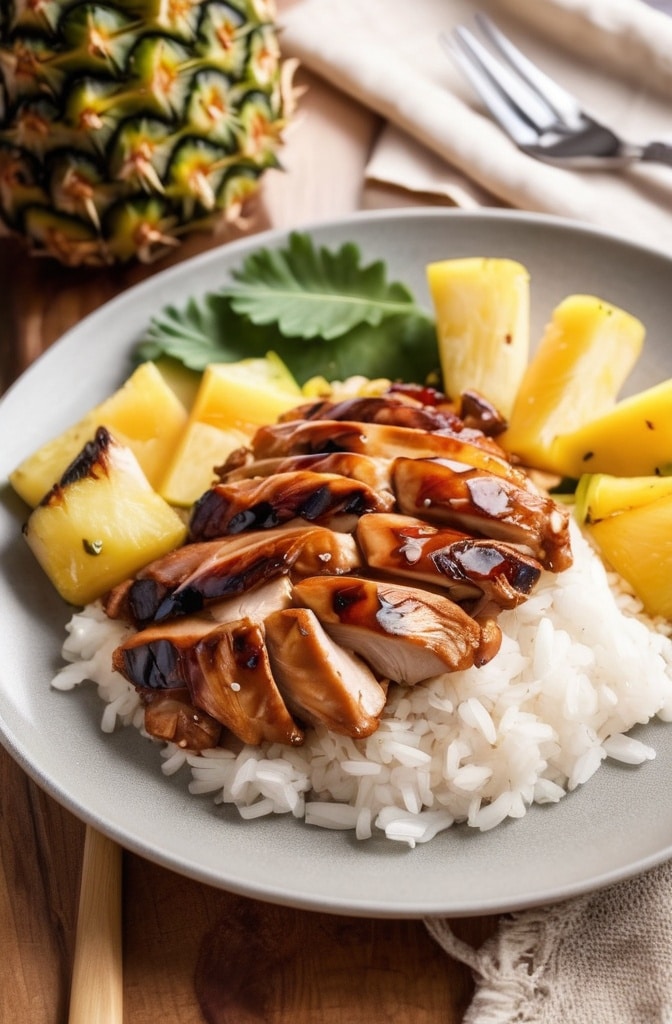
One common mistake is applying high heat too quickly. The high sugar content in Hawaiian teriyaki means it can burn before the chicken cooks through. The technique of searing and then finishing at a moderate temperature allows proper caramelization without charring. This process triggers the Maillard reaction—a chemical reaction between amino acids and reducing sugars that creates hundreds of new flavor compounds.
The traditional Hawaiian method involves continual basting rather than a single application of sauce. Each layer partially dries before the next is applied, creating a complex, multi-dimensional glaze that simply cant be achieved with a single coating. Think of it as building varnish on fine woodwork—patience and multiple thin layers yield superior results.
Authentic Hawaiian kitchens often use specialized grills called “hibachis” that provide intense, direct heat perfect for caramelizing teriyaki glazes. At home, a well-preheated cast iron skillet can approximate this effect. The superior heat retention creates more consistent caramelization across the meat surface.
Serving & Pairing Suggestions
In Hawaii, plate lunch style is the gold standard for serving teriyaki chicken. Arrange freshly grilled chicken alongside two scoops of steamed white rice (short-grain Japanese-style rice is preferred) and macaroni salad. The combination mite sound strange to uninitiated mainlanders, but the creamy mac salad provides the perfect counterpoint to the sweet-savory chicken.
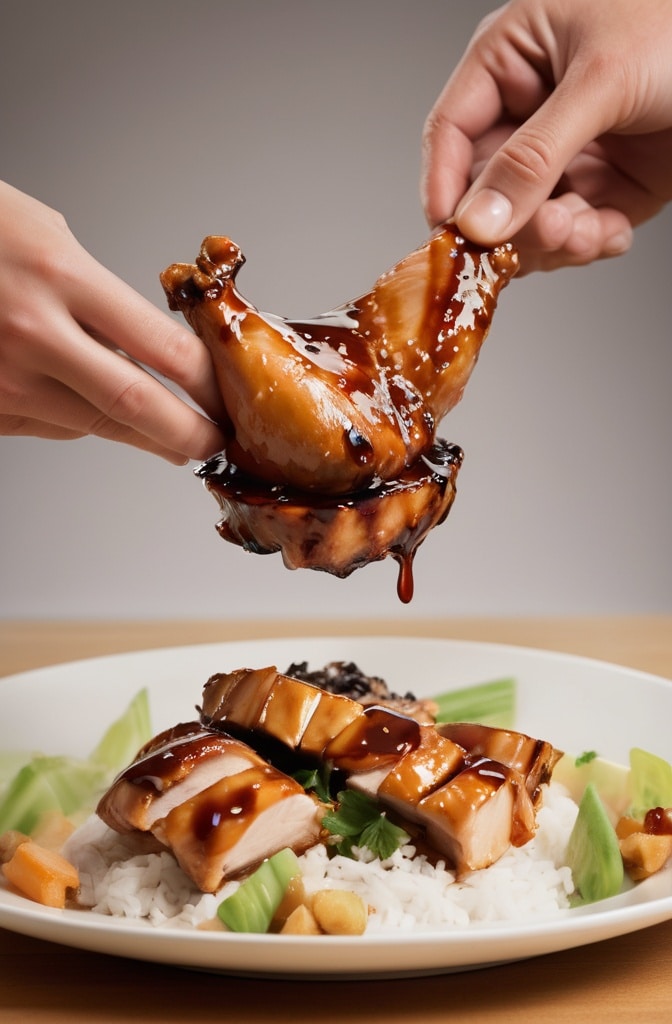
For a more elaborate meal, consider these authentic island sides:
- Lomi Lomi Salmon: Diced salted salmon with tomatoes and onions
- Poi: Traditional taro root paste (an acquired taste but culturally significant)
- Hawaiian-style cucumber kimchi: A nod to the Korean influence in Hawaiian cuisine
- Grilled pineapple slices: Brush with a bit of the teriyaki sauce before grilling
Beverage pairings should complement rather than compete with the bold flavors. A crisp Kona Brewing Company Longboard Lager, POG (passion-orange-guava) juice, or coconut water all work beautifully. For wine enthusiasts, an off-dry Riesling stands up nicely to the sweet-salty profile.
Garnish is not mere decoration in this dish—it’s an integral component. A generous sprinkle of toasted sesame seeds adds nutty crunch, while slivered green onions contribute fresh sharpness that cuts through the rich glaze. Some local spots add a light dusting of Japanese furikake (seaweed and sesame seasoning) for extra umami punch.
The plate should feel abundant but not fussy. Hawaiian cuisine celebrates generosity and comfort over pretentious presentation. That said, the chicken should be neatly sliced against the grain to showcase the glaze and ensure tenderness.
The Cultural Significance
Hawaiian teriyaki chicken tells the story of the islands themselves—a harmonious blend of Eastern and Western influences adapted to local ingredients and sensibilities. The dish emerged during the plantation era when Japanese workers adapted their traditional cooking methods using available ingredients.
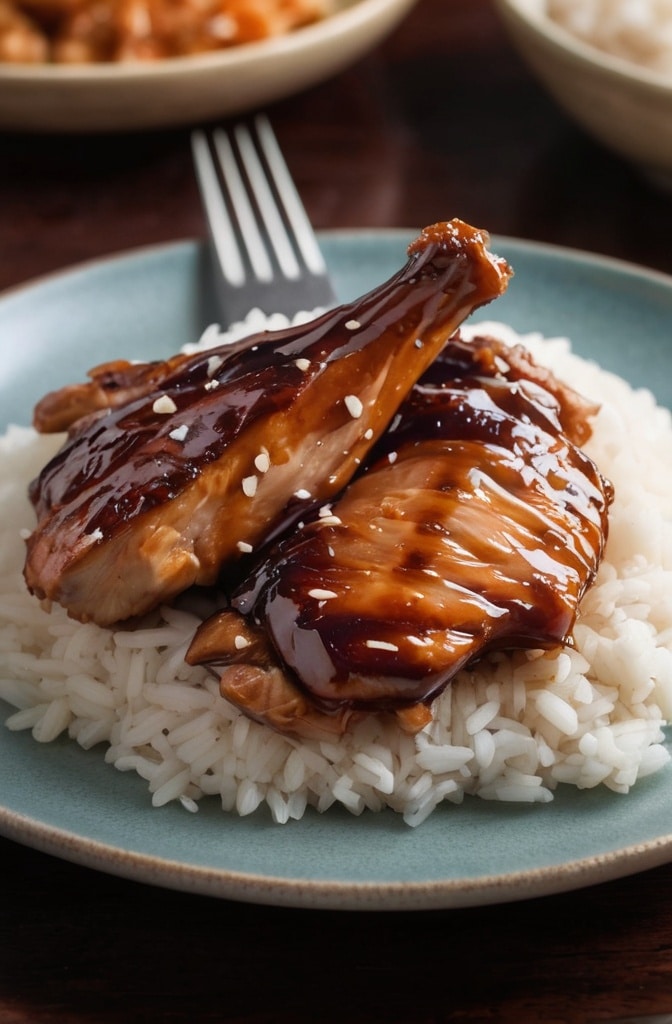
Unlike mainland American teriyaki, which often emphasizes convenience through bottled sauces, Hawaiian teriyaki celebrates process. The unhurried reduction of the sauce, the patient building of glaze layers, and the communal aspect of grilling reflect core Hawaiian values of patience and togetherness. Many island families have closely guarded teriyaki recipes passed down through generations, each with subtle variations that reflect their specific heritage.
In modern Hawaii, teriyaki chicken transcends ethnic boundaries as a unifying comfort food. You’ll find it at beach gatherings, in high-end restaurants reinterpreting local classics, and most meaningfully, at family celebrations where food serves as a physical manifestation of aloha spirit.
Make-Ahead and Storage Tips
Hawaiian teriyaki sauce actually improves with time as flavors meld and deepen. Make a double batch and store in an airtight container in the refrigerator for up to two weeks. The sauce may solidify slightly when cold due to the gelatin from the ginger and garlic; simply warm gently to restore pourable consistency.
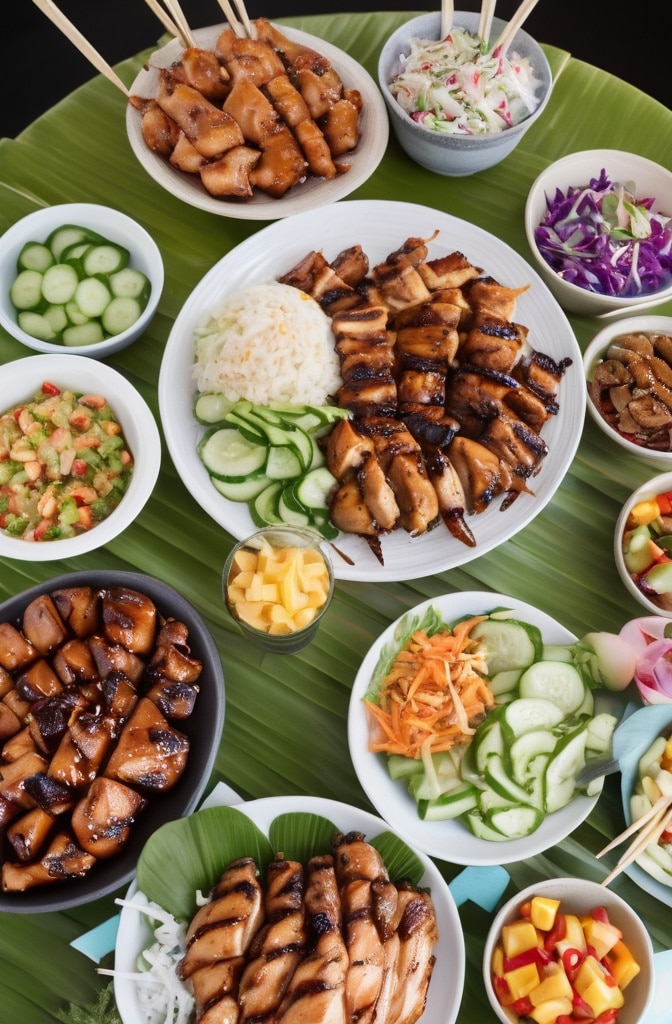
For meal prep convenience, marinate chicken portions in individual freezer bags before freezing. The chicken will marinate while thawing, saving valuable time on busy weeknights. Cooked teriyaki chicken retains its flavor well for 3-4 days refrigerated, though the texture is best enjoyed within 48 hours.
When reheating leftovers, add a splash of water or pineapple juice to prevent drying, and consider a quick turn under the broiler to revive the glaze’s luster. Some island chefs intentionally make extra for “teriyaki chicken fried rice” the following day—a brilliant repurposing strategy worth adopting.
Conclusion
Hawaiian-style teriyaki chicken represents the beautiful culinary fusion that defines the islands’ food culture. Its deceptive simplicity masks layers of technique and cultural significance that reward those willing to move beyond bottled shortcuts. The patience required—the marinating, the careful reduction of sauce, the methodical building of glaze—results in chicken that transcends the everyday version found in mainland shopping malls.
Master this dish, and you’ll gain more than a crowd-pleasing recipe; you’ll acquire an understanding of balance—sweet against salty, caramelized exterior against tender interior, tradition against innovation. Like Hawaii itself, this chicken embodies seemingly contradictory elements harmonized into something greater than their individual parts.
When made with care and authentic ingredients, Hawaiian teriyaki chicken isn’t just dinner—it’s an edible expression of aloha, connecting us to generations of island cooks who perfected this technique long before “fusion cuisine” became fashionable. Give it the time and attention it deserves, and it will reward you with flavors that transport you straight to those perfect Pacific shores.
Frequently Asked Questions?
Why is my teriyaki sauce not thickening properly?
The most common mistake is impatient reduction. Hawaiian-style teriyaki doesn’t typically use cornstarch like many mainland versions. Traditional thickening comes from proper reduction and the natural sugars caramelizing. If you’re short on time, you can add 1 teaspoon of cornstarch dissolved in 1 tablespoon cold water, but the texture and flavor won’t be quite the same as the slow-reduced authentic version.
Can I use chicken breast instead of thighs?
While you technically can substitute breast meat, you’ll sacrifice significant flavor and moisture. The higher fat content in thighs provides insurance against drying out during the high-heat cooking needed for proper glaze development. If you must use breasts, consider brining them first (1 hour in a solution of 4 cups water, ¼ cup salt, ¼ cup sugar) and reduce cooking time appropriately to prevent dryness.
Why does restaurant Hawaiian teriyaki taste different from my homemade version?
Two factors are likely at play: First, many Hawaiian restaurants use specialized grills that reach temperatures difficult to achieve at home, creating more intense caramelization. Second, commercial establishments often add a proprietary blend of fruit juices (guava and passionfruit are common) to their marinade for depth. Try adding 1-2 tablespoons of guava paste to your sauce for closer approximation.
How can I make this dish less sweet without losing authenticity?
Hawaiian teriyaki is characteristically sweeter than Japanese varieties, but you can reduce the sugar by up to one-third while maintaining cultural authenticity. Replace some brown sugar with pineapple juice reduction (simmer 2 cups juice down to ½ cup before adding to sauce) to maintain sweetness while reducing refined sugar content. The natural fruit sugars provide complexity that plain sugar lacks.
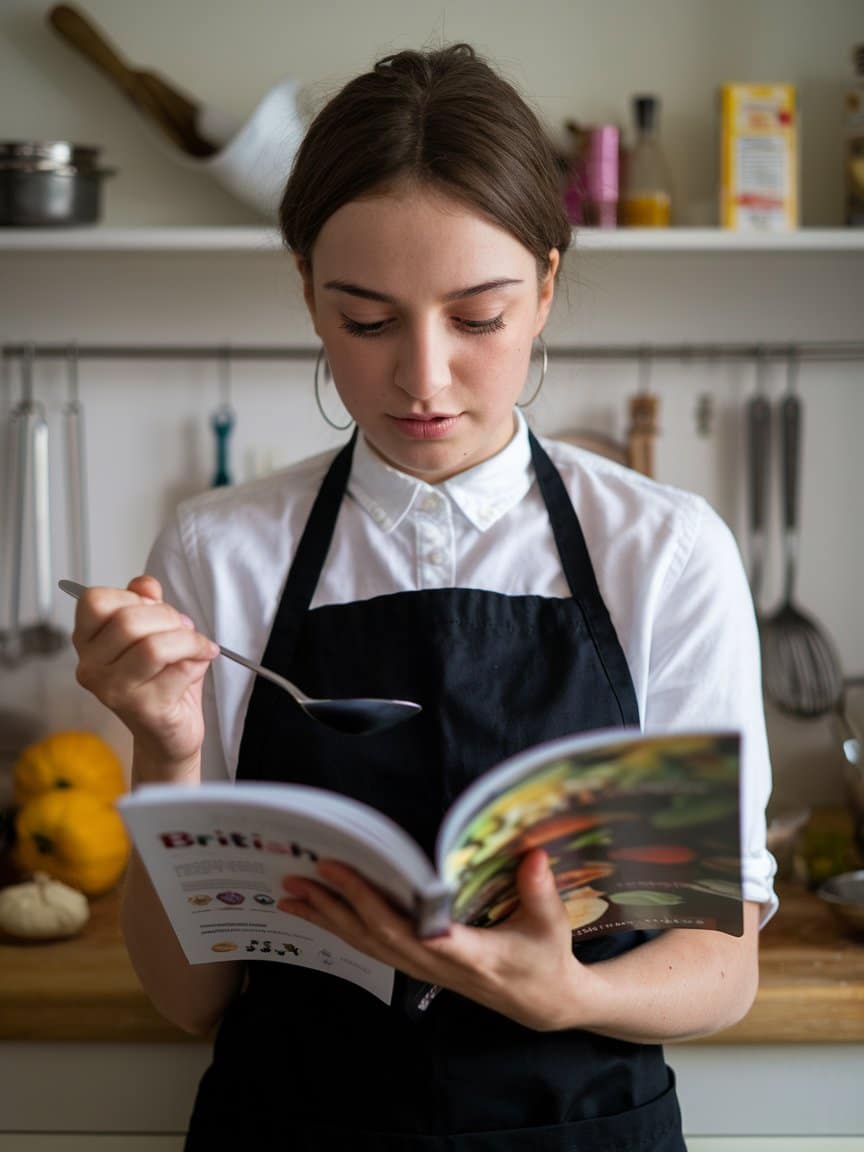
Veronica is a passionate food enthusiast with over three years of experience in exploring and writing about diverse cuisines. Her expertise lies in reviewing restaurants, sharing creative recipes, and discovering the latest food trends. As the voice behind FoodieRecap.com, Anju brings fresh perspectives and culinary insights to her audience.
